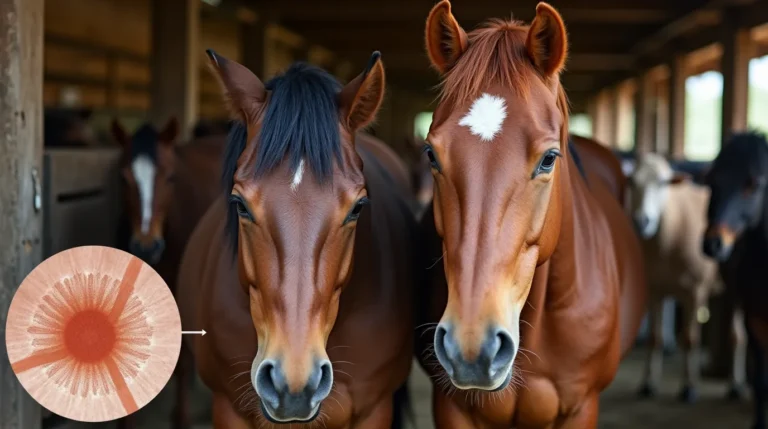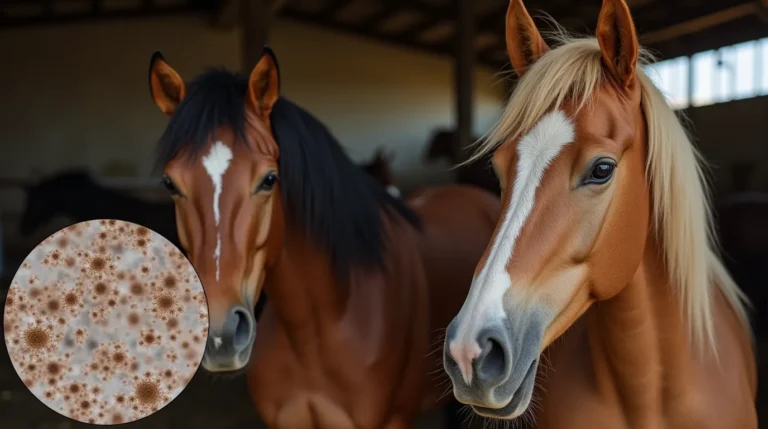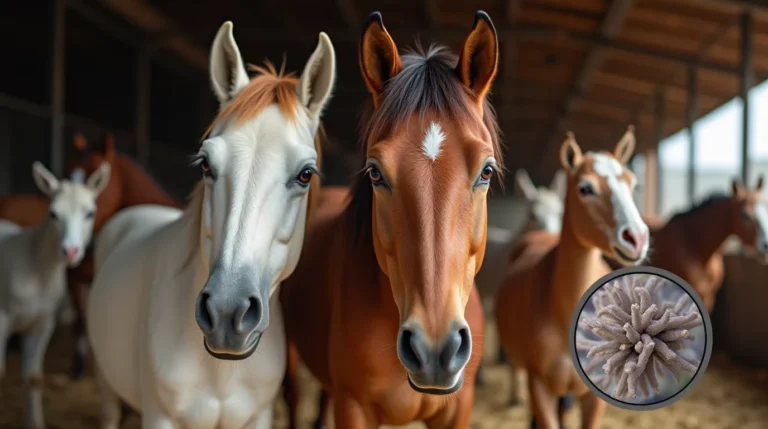Protect your horse’s health: Discover the 6 most common fungal infections in Horses, affecting horses, their symptoms, treatments, and prevention strategies.

Table of Contents
Fungal infections are a silent threat to equine health, potentially compromising your horse’s comfort, performance, and overall well-being. As a horse owner or caretaker, understanding these insidious infections can mean the difference between quick recovery and prolonged health challenges. In this comprehensive guide, we’ll explore six critical fungal infections that every horse owner should be aware of, providing insights into identification, treatment, and prevention.
What Are Fungal Infections in Horses?
Fungal infections in horses are opportunistic conditions caused by various fungal organisms that can attack the skin, hooves, and other body systems. These infections thrive in warm, moist environments and can spread quickly if not addressed promptly. Understanding the nature of these infections is crucial for maintaining your horse’s health and preventing widespread contamination.
The 6 Most Common Fungal Infections in Horses
1. Ringworm (Dermatophytosis)
Overview
Ringworm is perhaps the most recognizable fungal infection in horses, characterized by circular patches of hair loss and scaly skin.
Key Characteristics:
- Highly contagious
- Spreads through direct contact
- Common in young, stressed, or immunocompromised horses
Symptoms:
- Circular patches of hair loss
- Scaly, crusty skin
- Mild to moderate itching
- Potential spread to other animals and humans
Treatment Options:
- Topical antifungal medications
- Systemic treatments for severe cases
- Thorough cleaning of equipment and facilities
2. Thrush
Overview
A common hoof infection caused by anaerobic bacteria and fungi, typically affecting the horse’s frog and surrounding tissues.
Risk Factors:
- Consistently wet environments
- Poor hoof hygiene
- Lack of proper hoof care
- Limited exercise
Diagnostic Signs:
- Black, malodorous discharge
- Soft, deteriorating frog tissue
- Potential lameness
- Sensitivity when cleaning or trimming hooves
Prevention and Treatment:
- Regular hoof cleaning
- Maintaining dry living conditions
- Topical antifungal and antibacterial treatments
- Professional farrier care
3. Rain Rot (Dermatophilosis)
Overview
A bacterial and fungal skin infection exacerbated by wet, humid conditions.
Transmission Factors:
- Prolonged moisture
- Compromised immune system
- Insect bites
- Poor grooming practices
Clinical Presentation:
- Crusty, scabby lesions
- Matted hair
- Potential hair loss
- Mild to moderate pain
Management Strategies:
- Keeping horses dry
- Regular grooming
- Medicated shampoos
- Isolation of infected animals
4. White Line Disease
Overview
A progressive hoof condition affecting the horse’s white line, characterized by separation and potential structural damage.
Contributing Factors:
- Moisture exposure
- Poor hoof maintenance
- Mechanical stress
- Nutritional imbalances
Diagnostic Indicators:
- Separation of hoof wall
- Powdery or chalky appearance
- Potential lameness
- Compromised hoof structural integrity
Comprehensive Treatment:
- Professional farrier intervention
- Corrective trimming
- Antifungal treatments
- Addressing underlying nutritional issues
5. Candidiasis
Overview
A fungal infection caused by Candida species, typically affecting mucous membranes and potentially spreading systemically.
Vulnerable Areas:
- Mouth
- Digestive tract
- Reproductive systems
Risk Indicators:
- Prolonged antibiotic use
- Compromised immune system
- Stress
- Poor nutrition
Management Approach:
- Veterinary diagnostic testing
- Targeted antifungal medications
- Probiotics
- Dietary modifications
6. Melanoma-Related Fungal Complications
Overview
While not exclusively fungal, melanomas in horses can create environments conducive to secondary fungal infections.
Associated Risks:
- Compromised skin integrity
- Increased infection vulnerability
- Potential systemic complications
Monitoring Strategies:
- Regular veterinary examinations
- Early detection
- Comprehensive skin assessments
Recommended Pet Products on Amazon
- Vetericyn Plus Equine Wound and Skin Care
- Zymox Enzymatic Ear Solution
- Banixx Horse and Pet Care Spray
- Shapley’s M-T-G Original Horse Hair Grooming Solution
Preventing Fungal Infections: Best Practices
- Maintain clean, dry living environments
- Practice regular grooming
- Implement strict hygiene protocols
- Provide balanced nutrition
- Minimize stress
- Conduct routine veterinary check-ups
Fungal Infections in Horses (FAQ)
Q1: How quickly do fungal infections spread? Fungal infections can spread rapidly, often within days, especially in warm, moist conditions.
Q2: Can humans contract fungal infections from horses? Some fungal infections, like ringworm, are zoonotic and can transmit between horses and humans.
Q3: Are certain horse breeds more susceptible? While no breed is immune, horses with compromised immune systems or those living in high-moisture environments are more vulnerable.
Q4: How expensive are fungal infection treatments? Treatment costs vary but can range from $50 to $500, depending on the infection’s severity and required interventions.
Conclusion
Understanding and proactively managing Fungal Infections in Horses crucial for maintaining your horse’s health and well-being. By recognizing early symptoms, implementing preventive strategies, and seeking professional veterinary guidance, you can protect your equine companion from these potentially debilitating conditions.
Call to Action: Share your experiences with fungal infections in horses or leave a comment below. For more expert pet care recommendations, visit BlithePet
Additional Resources
- Consult with a veterinarian specializing in equine health
- Join local horse owner support groups
- Stay informed about emerging veterinary research
Disclaimer: This article is for informational purposes and should not replace professional veterinary advice.





